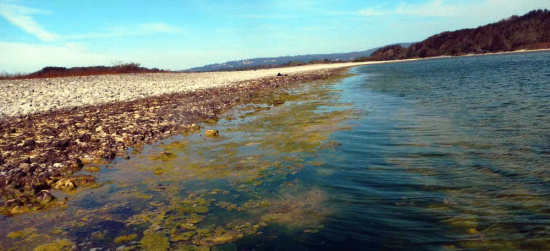
Photo: Eel River Recovery Project
All the fish news these days is of the superboss salmon year that 2012 has turned out to be — nothing like the old days, of course, but at least an improvement over the total poverty of much of the last decade. Ace fish reporter Dan Bacher recently reported that leading up to Aug. 31 around 300,000 salmon have been taken by commercial and recreational fishermen off the California coast, a heartening development he attributes partly to the larger volume of water the Bureau of Reclamation has been ordered to send down the Klamath and the Trinity.
But all is not well on the Eel River, according to a release today from Pat Higgins’ Eel River Recovery Project. Last week saw the first of the project’s annual fish-counting dives along the lower Eel, and the news was not good: Low flows and stagnant, murky water led to few fish found.
Why is this? In its press release, the EERP allows that because of river conditions, this first survey likely missed many fish that would otherwise be found, as water quality and quantity were both extremely poor. The river is at half its historic level this year, despite this being an average rain year. This fact, of course, has recently entered into the debate over the regulation of marijuana super-grows in the county. The working hypothesis is that all that missing water is being sucked up by illicit industrial farmers in the Eel and Van Duzen watersheds.
Press release from the Eel River Recovery Project follows. Want to help in their next count? It’s happening Oct. 13. Details below.
Eel River Early Fall Chinook Salmon Dive Count Finds Low Flows and Few Fish
The Eel River Recovery Project (ERRP), the Wiyot Tribe and the Bear River Tribe of the Rohnerville Rancheria sponsored a dive of the lower Eel River to count the early run of fall Chinook salmon on Friday, September 28. Volunteers with little experience joined teams with seasoned divers, including experienced fisheries consultants and staff from the Wiyot Environmental Department, U.S. Fish and Wildlife Service and National Marine Fisheries Service.
Two teams of ten covered pools from below Fernbridge to the River Lodge and the second pools extending upstream to Weymouth Bluffs above the Van Duzen River. Only 75 adult Chinook salmon were counted, 18 small male “jack” Chinook, 54 adult steelhead and 294 “half pounder” steelhead were counted. Counts likely substantially under-estimated the Chinook salmon numbers because of unexpected factors that confounded getting an accurate count.
The Eel River closes to catch-and-release angling on October 1 unless the Eel River is flowing at 300 cubic feet per second, but prior to that date fishing can occur in very low flows. Although the Eel River was only flowing at 63 cfs at Scotia, according to the U.S. Geologic Survey gauge there, anglers were out in full force and even prevented the lower dive team from entering some pools where fish held. Other pools where fish were concentrated had no visibility due to algae dislodged by fishermen.
The flow of the Eel and its tributaries is approximately half of the long term averages for the date despite rainfall being in the range of normal. Thick mats of algae line the shore of the lower Eel River and potential toxic blue-green algae species can be intermixed. Divers in the Weymouth Pool below Howe Creek encountered floating algae mats and many contracted swimmer’s itch. Thick mats of algae also cover the stream bottom and could create adverse conditions for salmon and steelhead, such as depressed dissolved oxygen. Vandals broke into one of the ERRP vehicles off East Ferry Road and stole a gear bag containing project dive gear and masks and snorkels.
The Eel River Recovery Project is a volunteer based organization that wants to help collect better water quality and fisheries data on the Eel River and to support grassroots restoration. The condition of the lower Eel River would suggest that water conservation and nutrient pollution prevention are necessary to help it regain its health. The next dive is scheduled for Saturday, October 13. Unless flow conditions change before then, only lower pools will be censused. Divers will again meet River Lodge at 8:30 AM, but anyone interested in volunteering should check in before with ERRP Volunteer Coordinator Pat Higgins at 707 223-7200. See www.eelriverrecovery.org for more information.
CLICK TO MANAGE